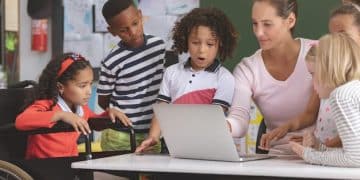How Schools Promote Diversity and Inclusion: A US Perspective

Schools in the US are promoting diversity and inclusion in the classroom through inclusive curriculums, diversity training, inclusive language and celebrating diverse holidays.
In today’s educational landscape, creating a welcoming and inclusive environment for all students is a top priority. How are schools promoting diversity and inclusion in the classroom? Many schools are actively implementing various strategies to ensure every student feels valued, respected, and supported.
Understanding Diversity and Inclusion in Education
Diversity and inclusion in education go beyond simply acknowledging differences. It’s about creating an environment where every student, regardless of their background, feels a sense of belonging and can thrive. It encompasses race, ethnicity, gender, sexual orientation, socioeconomic status, religion, and ability.
Essentially, diversity represents the presence of various identities, while inclusion focuses on ensuring that all individuals have equal access to opportunities and resources. When these principles are effectively implemented, students are more likely to engage in learning, develop empathy, and achieve their full potential.
Key Components of Diversity and Inclusion
Diversity and inclusion in schools are multifaceted concepts that require focused and thoughtful attention. Understanding the key components is crucial for creating a genuinely inclusive environment.
- Representation: Ensuring that the student body, faculty, and staff reflect the diversity of the broader community.
- Equity: Providing all students with the resources and support they need to succeed, regardless of their background.
- Accessibility: Making the physical environment and curriculum accessible to students with disabilities.
- Respect: Fostering a culture of respect and understanding for all identities and perspectives.
Prioritizing these key ingredients will certainly transform the learning environment for students.
In conclusion, understanding diversity and inclusion in education is paramount for cultivating an equitable and supportive learning environment where all students feel valued and empowered.
Inclusive Curriculum Development
One of the most impactful ways schools are promoting diversity and inclusion is through inclusive curriculum development. This involves carefully selecting and designing learning materials that reflect the diverse experiences, perspectives, and contributions of all students.
By including a wide range of voices and stories, educators can help students develop a more comprehensive understanding of the world and their place in it. This also helps students to feel seen and valued, as they recognize their own identities and experiences represented in the curriculum.

Strategies for Creating Inclusive Curricula
Creating an inclusive curriculum requires careful planning and consideration. Here are some strategies that schools can use to ensure their curriculum is representative and respectful of all students.
- Diversify Reading Lists: Include books by authors from diverse backgrounds and that feature characters with different identities.
- Incorporate Multiple Perspectives: Present historical events and social issues from various viewpoints, encouraging critical thinking and empathy.
- Integrate Cultural Celebrations: Celebrate diverse holidays and cultural events throughout the year, providing opportunities for students to learn about different traditions.
Developing an inclusive curriculum ensures an enhanced education for all students. It fosters a sense of belonging, appreciation and the understanding of different cultures, beliefs and backgrounds.
In summary, inclusive curriculum development is essential for creating a learning environment where all students feel represented, valued, and empowered to succeed.
Diversity Training for Educators
To effectively promote diversity and inclusion, it’s crucial for educators to receive comprehensive diversity training. This training helps teachers develop a deeper understanding of different identities, cultures, and perspectives, as well as the challenges that students from marginalized groups may face.
By equipping educators with the knowledge and skills they need to create inclusive classrooms, schools can foster a more welcoming and equitable environment for all students. This also helps teachers to address bias, promote cultural sensitivity, and create a culturally responsive pedagogy.
Benefits of Diversity Training
Diversity training is an important investment in the future of education. It offers several benefits for both teachers and students.
- Increased Awareness: Helps teachers understand their own biases and assumptions.
- Improved Communication: Enhances teachers’ ability to communicate effectively with students from diverse backgrounds.
- Enhanced Cultural Sensitivity: Promotes greater understanding and appreciation of different cultures and perspectives.
With ongoing workshops and training, teachers are better equipped to integrate diversity within their lessons and interactions with students. As teachers build confidence in this area, learning engagement and outcomes will increase.

In conclusion, investing in diversity training for educators is essential for creating inclusive classrooms that foster a sense of belonging, respect, and equity for all students.
Creating Inclusive Language Guidelines
The language we use can have a profound impact on how people feel and perceive the world around them. Schools are increasingly recognizing the importance of creating inclusive language guidelines to ensure that the words we use are respectful, accurate, and empowering.
Inclusive language is free from bias, stereotypes, and assumptions about different groups of people. It avoids language that could be offensive, discriminatory, or marginalizing. By adopting inclusive language guidelines, schools can foster a more welcoming and equitable environment for all students.
Examples of Inclusive Language
Adopting an inclusive language policy promotes the use of thoughtful consideration regarding word choice.
- Use Person-First Language: When referring to people with disabilities, focus on the person rather than the disability (e.g., “a student with autism” rather than “an autistic student”).
- Avoid Gendered Language: Use gender-neutral terms when referring to people whose gender is unknown or irrelevant (e.g., “chairperson” instead of “chairman”).
- Use Specific and Accurate Language: Avoid making generalizations or assumptions about different groups of people.
By being thoughtful and aware of the language used, the classroom setting can become a safer and more inclusive space.
In conclusion, creating inclusive language guidelines is an important step towards fostering a more respectful, equitable, and welcoming environment for all students.
Celebrating Diverse Holidays and Cultural Events
Celebrating diverse holidays and cultural events can be a powerful way to promote diversity and inclusion in schools. By recognizing and honoring the traditions and customs of different cultures, schools can help students develop a deeper understanding and appreciation of the world around them.
This also provides opportunities for students to share their own cultural heritage and experiences, fostering a sense of belonging and connection. When students feel seen and valued for their unique identities, they are more likely to engage in learning and develop empathy for others.
Incorporating diverse holidays into lesson plans is an amazing opportunity for education and awareness. Exposure to these important days can broaden a student’s understanding and appreciation for different cultures and traditions.
In summary, celebrating diverse holidays and cultural events is an effective way to promote diversity and inclusion, foster a sense of belonging, and create a more welcoming and equitable environment for all students.
Promoting Student-Led Initiatives
Empowering students to take the lead in promoting diversity and inclusion can be incredibly impactful. Student-led initiatives can help to create a more inclusive school culture, raise awareness about important issues, and foster a sense of ownership and responsibility among students.
By providing students with the resources and support they need to lead these initiatives, schools can empower them to become agents of change in their own communities. This also helps students develop valuable leadership skills, critical thinking abilities, and a deeper understanding of social justice issues.
Empowering students to lead diversity and inclusion initiatives involves providing them with the necessary resources, support, and guidance to make a meaningful impact. Here’s a good place to start:
- Student Diversity Clubs: Encourage students to form clubs focused on specific aspects of diversity, such as LGBTQ+ issues, racial justice, or disability awareness.
- Peer Mentoring Programs: Pair students from different backgrounds to provide support and build understanding.
- Student-Led Workshops: Offer workshops led by students on topics related to diversity and inclusion.
Ultimately, students who are part of the change are more likely to sustain it.
The Role of Parents and the Community
Promoting diversity and inclusion in schools is not solely the responsibility of educators and students. Parents and the community also play a vital role in creating a more welcoming and equitable environment for all learners.
By engaging parents and community members in the conversation, schools can foster a sense of shared responsibility and build stronger connections between the school and the broader community. This also provides opportunities for parents and community members to share their own experiences and perspectives, enriching the learning environment for all.
Parents can also contribute to diversity and inclusion efforts by reinforcing inclusive values at home. By modeling respectful behavior, challenging stereotypes, and engaging in conversations about diversity and inclusion, parents can play a powerful role in shaping their children’s attitudes and beliefs.
Lastly, the community offers a wealth of resources that schools can tap into to enhance their diversity and inclusion efforts. By collaborating with local organizations and community leaders, schools can provide students with unique learning opportunities and connect them with mentors and role models from diverse backgrounds.
| Key Aspect | Brief Description |
|---|---|
| 🤝 Inclusive Curriculum | Curriculum reflects diverse perspectives and experiences. |
| 🗣️ Diversity Training | Educators learn to create inclusive classrooms. |
| 🎉 Cultural Celebration | Celebrating diverse holidays fosters belonging. |
| 🌱 Student Initiatives | Empowering students to lead inclusion efforts. |
Frequently Asked Questions
▼
Diversity and inclusion are important because they create a welcoming and equitable environment for all students. It promotes understanding, respect, and empathy among students from different backgrounds, preparing them to be global citizens.
▼
Inclusive classroom practices include using diverse materials, promoting respectful communication, adapting instruction to meet individual needs, and celebrating diverse holidays and cultural events.
▼
Schools can support LGBTQ+ students by implementing inclusive policies, providing access to resources and support groups, training staff on LGBTQ+ issues, and creating a safe and affirming environment for all students.
▼
Parents can promote diversity and inclusion by modeling respectful behavior, engaging in conversations about diversity with their children, challenging stereotypes, and supporting school initiatives that aim to create a more inclusive environment.
▼
Schools can address bias and discrimination by implementing clear policies against discrimination, providing training for staff and students, creating reporting mechanisms for incidents of bias, and taking swift and appropriate action when incidents occur.
Conclusion
In conclusion, promoting diversity and inclusion in the classroom is an ongoing process that requires commitment, effort, and collaboration from all stakeholders. By implementing the strategies outlined in this article, schools can create a more welcoming, equitable, and empowering environment for all students, preparing them to thrive in an increasingly diverse and interconnected world.





